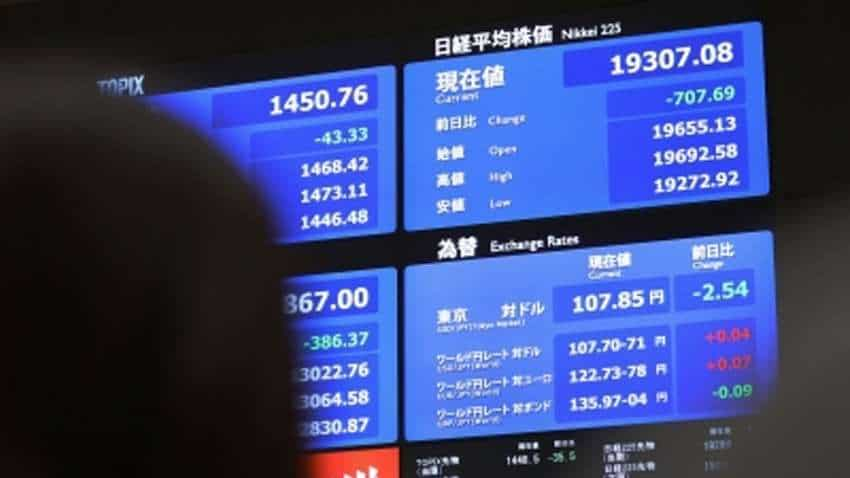Here is why US equities declined in the week - What Dow, S&P 500 and Nasdaq lost
For the week ending on Friday, the Dow and S&P 500 lost 0.6 per cent and 1 per cent, respectively, while the Nasdaq fell 0.7 per cent.

US equities declined in the week as market sentiment was dampened amid uncertainty over the country's additional fiscal stimulus and soaring Covid-19 cases.
For the week ending on Friday, the Dow and S&P 500 lost 0.6 per cent and 1 per cent, respectively, while the Nasdaq fell 0.7 per cent.
The S&P US Listed China 50 index, which is designed to track the performance of the 50 largest Chinese companies listed on US exchanges by total market cap, logged a weekly rise of 0.5 per cent.
Wall Street cautiously followed updates on an additional US Covid-19 aid package as lawmakers struggled to push through new fiscal stimulus before year-end.
The White House on Tuesday proposed a new 916-billion-US-dollar Covid-19 relief package to Congress as the US economy faces the risk of a double-dip recession amid the pandemic.
US Treasury Secretary Steven Mnuchin and Democratic House Speaker Nancy Pelosi had been negotiating a new Covid-19 relief package for months, but failed to reach an agreement before the presidential election in November, Xinhua reported.
The new proposal made by the White House marked the Trump administration's first move since Election Day to break the months-long standoff in relief talks.
Yet, the outlook remained uncertain as Democrats and Republicans divided on the scope and size of a possible deal.
Without a new relief package, many Americans will soon lose their unemployment benefits and begin to face hardships like eviction and foreclosure by the end of the year.
The upward trajectory of Covid-19 infections in the United States continued, with record numbers of cases, deaths as well as hospitalizations repeatedly seen across the states in December.
The US caseload surpassed 16 million with the death toll exceeding 297,000 as of Saturday afternoon, according to data compiled by Johns Hopkins University.
A surging viral outbreak is weakening the US job market and threatening the economic recovery.
US initial jobless claims, a rough way to measure layoffs, jumped to 853,000 in the week ending December 5, following an upwardly revised 716,000 in the prior week, the Department of Labour reported on Thursday, topping a Dow Jones estimate of 730,000.
It marked the highest number of initial claims being filed since September.
Earlier this month, data released by the US Bureau of Labour Statistics showed US employment growth slowed last month.
The US economy added 245,000 jobs in November, following a downwardly revised 610,000 in October, well below a Dow Jones consensus estimate of 440,000.
The unemployment rate edged down to 6.7 per cent from 6.9 per cent in October, roughly in line with expectations.
"With so much economic uncertainty and many unknowns surrounding the pandemic and potential vaccine, the next six months will be critical," Mitch Zacks, CEO at Zacks Investment Management, said in a note on Saturday.
"Instead of getting caught up in the short-term volatility, I recommend focusing on the long-term outlook. This means focusing on hard data and economic indicators to help guide your investments for what's ahead," he said.
Get Latest Business News, Stock Market Updates and Videos; Check your tax outgo through Income Tax Calculator and save money through our Personal Finance coverage. Check Business Breaking News Live on Zee Business Twitter and Facebook. Subscribe on YouTube.
10:27 AM IST











 Zomato set to debut in Sensex, replacing JSW Steel
Zomato set to debut in Sensex, replacing JSW Steel Hamps Bio shares debut at 90% premium on BSE SME platform
Hamps Bio shares debut at 90% premium on BSE SME platform Traders' Diary: Buy, sell or hold strategy on Piramal Pharma, Vedanta, Thermax, Indus Tower, and other top stocks today
Traders' Diary: Buy, sell or hold strategy on Piramal Pharma, Vedanta, Thermax, Indus Tower, and other top stocks today Swiggy shares rise nearly 2% after Axis Capital initiates ‘buy’ rating
Swiggy shares rise nearly 2% after Axis Capital initiates ‘buy’ rating GIFT Nifty futures down 100 points; markets to track Fed meeting, Chinese data
GIFT Nifty futures down 100 points; markets to track Fed meeting, Chinese data